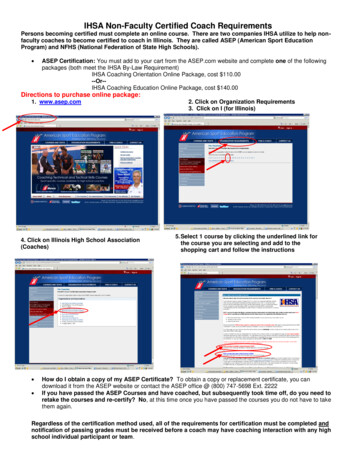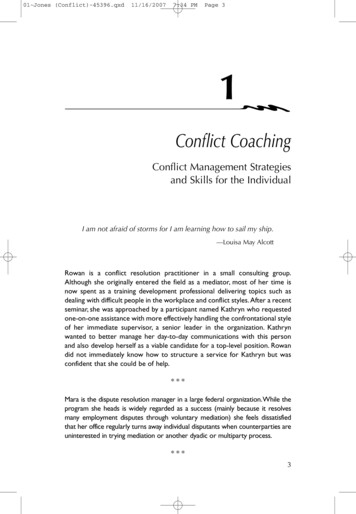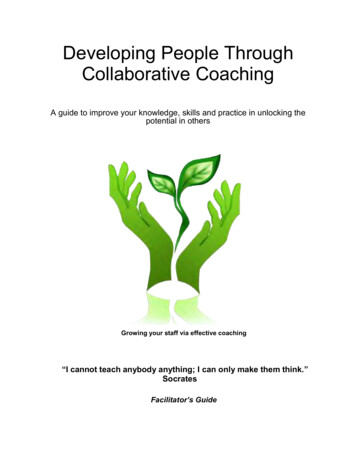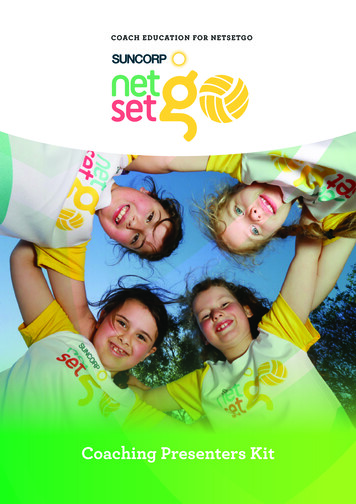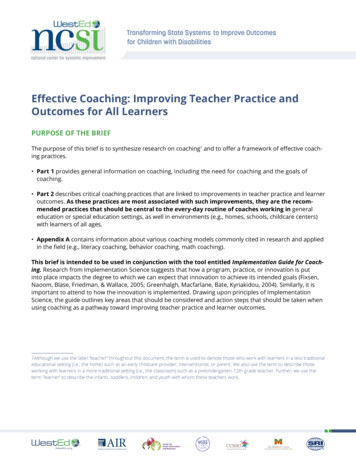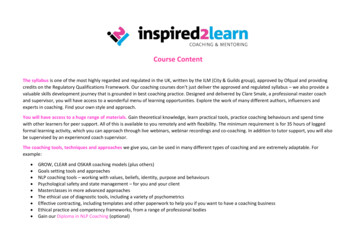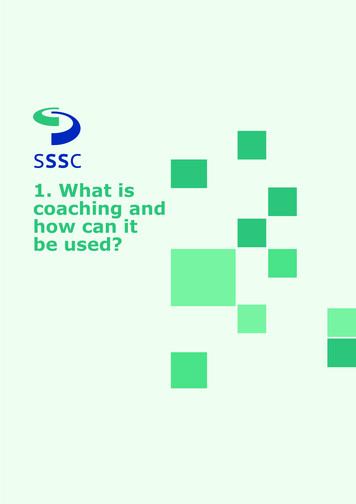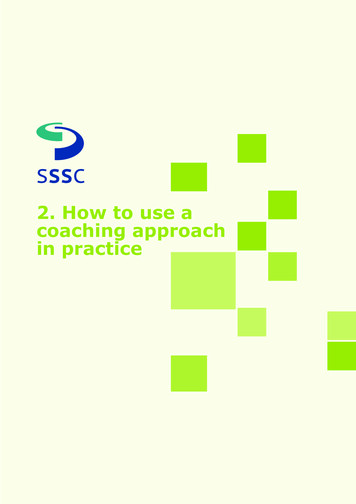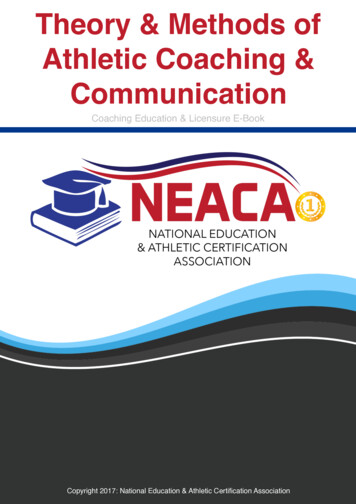
Transcription
Theory & Methods ofAthletic Coaching &CommunicationCoaching Education & Licensure E-BookCopyright 2017: National Education & Athletic Certification Association
2ContentsCourse Objectives3Coaching Communication Systems 4The Athletic Environment23Being Recruitable56Assignments88Theory & Methods of Athletic Coaching & Communication
Course Objectives Gain a working knowledge of the best practices regardingathletic communication with the athletes, parents andadministration. Gain a working knowledge of best practices that createthe most efficient & productive practice environmentsthrough improved communication techniques. Gain a working knowledge of best practices to create themost efficient & productive competitive environmentthrough improved communication techniques. Gain a working knowledge of the concepts needed toeliminate cognitive bias and establish a learningenvironment through culture change. Gain an understanding of how to create an environmentthat has the fewest risk factors involved in competitivestress for the athletes. Gain a working knowledge of the concepts of collegerecruiting to assist athletes & parents through thatprocess. Gain an Understanding of what college coaches arelooking for in athletes.Title of the book3
Coaching Theory &MethodsCoaching CommunicationSystemsCopyright 2017: National Education & Athletic Certification Association
Coaching Communication SystemPurpose In todays society, athletics, has taken on alife of its own. It has infiltrated every aspectof our daily lives. This is not to say that itthis athletics is negative in any way, justthat we have a heightened focus on thebenefits of participation and being aspectator. The statistical participation rates in theUnited States have been reported as highas 70 million youth sport athletes (ages6-18). This puts a huge stress on the need forcoaches. In order to meet the demandingand growing need for coaches, they canoften end up in precarious positionswithout the appropriate education.Theory & Methods of Athletic Coaching & Communication5
Coaching Communication SystemProductivity The main focus of athletics is still to provide a positivephysical and emotional environment for competitiveactivities. Within that framework a coach must deliver anenvironment that improves skill and sport specificknowledge in order to execute in competition.7 Steps To Increase Productivity1. Build & use team language - eliminatecommunication confusion2. Timed practice plans - start & stop times oneverything3. Give your assistant coach the stopwatch4. Command based coaching instruction - :60Lessons5. Corrective coaching with no practice stoppage - :07Terms6. Coach guided athlete self-correction: “Figure It out”7. Model Energy & communication tactics- Starts withthe coachesTheory & Methods of Athletic Coaching & Communication6
Coaching Communication SystemEfficiencyDefined: Accomplishing more in the same amount of time. Accomplishing what was supposed to beaccomplished in a lessor amount of timeThe 7secondcoach system decreases the amountof down time for instruction & corrective coaching i.e. - if you average 4 min. per technique &taught 5 techniques per day 20 min. ofinstruction :60lessons 5 min. of technical instruction 15 min. of additional practice time more reps more confidence i.e. - if you average 10 stoppages per practiceto reteach technique & averaged 2 minutesper stoppage 20 minutes of lost practicetime :07terms no stoppage 20 min. ofadditional practice time more reps more confidence* Times and numbers based off using this high level communication style.Theory & Methods of Athletic Coaching & Communication7
Coaching Communication SystemEfficiency7 Steps to Increasing Efficiency1. Commit to building & using common team language2. Use transition cues to maintain engagement3. Detailed practice plan - start & stop times on allsections4. Command based instruction - :60Lessons5. Corrective coaching with :07Terms no practicestoppage6. Progressive practice plans - each additional techniquemust use prior knowledge7. Give your assistant coach a stopwatch - to time you*Important Side Note* Don’t be afraid to get off of the practice schedule - bediligent in adjusting what your doing to get back on track! If your practice plans change - document everything sothe progression for the next day can be appropriate anduninterrupted.Theory & Methods of Athletic Coaching & Communication8
Coaching Communication SystemNon-Negotiable’sDefined: The characteristics that you expect your team to both:Exemplify and Eliminate The resolute positives that you always want to see outof your athletes The negatives the you absolutely never want to see inyour athletes7 Components of Developing Non-Negotiables based on your personal & athletic principles based on your programs objectives based on your value system based on your reward system based on your consequence system based on your coaching approach based on your institutional rules & regulationsNon-Negotiable Side-Note: Any prescribed consequence is delivered regardlessof an athletes position/status on the team! All non-negotiables are not incident specific!Theory & Methods of Athletic Coaching & Communication9
Coaching Communication SystemCore FundamentalsDefined: The skills and athletic attributes needed to performthe basic techniques of the sport successfully. Thefoundational techniques and movements neededfor success at the specific level of play.Purpose of Defining & Developing CoreFundamentals:1. Entrance skills of your respective sport2. Progressive technique system- meaning that morecomplex skills can be built off of these basics3. Base for success4. Eliminates coach to coach communicationconfusion5. Ability evaluation tool6. Systematic approach to skill development7. Develops complete technical understandingTheory & Methods of Athletic Coaching & Communication10
Coaching Communication SystemCore Fundamentals7 Steps to Developing Core Fundamentals1. How many levels of the sport can athletes compete at foryour respective team (City Rec League-YMCA-AAULittle League-Freshman-JV-Varsity-etc.)?2. What baseline skills must be learned in order to be ableto play the sport?3. What basic skills are needed in order to advance fromthe first level (that you defined above) to the 2nd level inthe sport?4. What basic skills must the athlete posses in order trainon their own in the sport?5. What are the basic skills needed for winning at acompetitive level in the sport?6. What are the basic skills needed for winning at the elitelevels in the sport?7. Design the fundamental training program from 6-1.By following the steps above, this should help you outlineyour core fundamentals and then progressively teach morecomplex techniques and skills as the athlete progressthrough your program.Theory & Methods of Athletic Coaching & Communication11
Coaching Communication System:60 Lessons The attention span of our youth today is shorterthan ever before in history goldfish attention span: 9 seconds teenager attention span: 8 secondsHere is the spiraling staircase:1. The longer we talk the less they hear2. The less they hear the less they understand3. The less they understand the more you have toreteach4. The more you reteach the less they get tophysically practice repetitions5. The less they get to physically practicerepetitions the less confident they are6. As confidence decreases so does performanceproduction - this can all be eliminatedTheory & Methods of Athletic Coaching & Communication12
Coaching Communication System:60 Lessons7 Steps to Developing :60 Lessons1. Teach NEW technique & skills in :60 lessons orless2. Identify your non-negotiable fundamentaltechniques3. Identify the body positioning and all actionterms needed to perform the fundamentaltechniques4. Have no more than 2 cue words in eachsentence for action items (:07 terms)5. No more than 5 sentences to explain thattechnique6. Test that each skill can be taught in :60 or less- if not - modify7. Teach progressive techniques - previouslylearned techniques reduce instruction time &the learning curveTheory & Methods of Athletic Coaching & Communication13
Coaching Communication System:07 termsDefined: :07 Terms are cue words and triggers foraction steps in the fundamental techniquesfor your sport Use these cue words and triggers inpractice. When these cue words and triggers areconsistently used, they becomemeaningful in competition. These cue words & triggers keep practicepace elevated for increased efficiency. The cue words & triggers reducecommunication confusion. Reduced communication confusiondecreases competitive anxiety. Lower levels of competitive anxietyincrease competitive performance &production.Theory & Methods of Athletic Coaching & Communication14
Coaching Communication System:07 termsDeveloping :07 Terms1. Your :07 Terms are created when youdevelop your :60 lessons.2. :07 terms are all body positioning/technical landmarks and teaching pointsincorporated into your :60 Lessons.3. If you built your :60 Lessons properly thisstep has already been completedSide Note:07 terms are specific to :60 lessons and not mindsettalks or motivational phrases that a coach tells theirathletes. They also are not mantra’s such as “hustle”,“keep working”, “Attack”, etc. Theory & Methods of Athletic Coaching & Communication15
Coaching Communication SystemPractice Organization Knowing what to teach is not the challenge- it’s developing an organized & systematicway of delivering that knowledge. Sport is fluid and as things come-up in apractice it is very easy to get off track being disciplined with your practice planskeeps you on track. It is impossible to consistently reducelearning curves (which increasesconfidence & ultimately performance!) ifyou are not logging in what you areteaching on a daily basis.Theory & Methods of Athletic Coaching & Communication16
Coaching Communication SystemPractice OrganizationDeveloping An Organized Practice Plan1. Backward design from the skills needed to win achampionship at your level at the end of theseason2. Block Series & Systems together so you scaffoldthem for reduced learning curves3. You can’t be “detailed enough” - Time everything- that means everything from H2O breaks to :60Lessons - Everything has a place & time on thepractice plan4. Build tomorrow’s practice plan from todayspractice plan (scaffold & progression)5. Always have a place for notes in case you get offthe plan so you know what you did & didn't cover6. Don’t adjust practice start & end times - becomemore efficient7. Keep all practice plans for an annual year endreview to determine efficiency & productivityTheory & Methods of Athletic Coaching & Communication17
Coaching Communication SystemCognitive BiasDefined A genuine deficiency or limitation in our thoughtprocess that creates a flaw in judgement arisingfrom memory, social experience, misjudgmentsor conditioned thinkingTypes of Cognitive Bias1. Confirmation bias A personal bias that becomes fact if anyoneelse agrees with it2. Functional fixedness Thinking that ideas and objects are used acertain way - no exceptions3. Negativity bias A negative experience effects decisionmaking more than a positive experience4. Projection bias The assumption that other people think likewe do making our bias rightTheory & Methods of Athletic Coaching & Communication18
Coaching Communication SystemCognitive BiasTypes of Cognitive Bias5. Bandwagon effect The more people that believe it or do it - mustmake it acceptable or right6. Status Quo bias Choices designed to eliminate change regardless of whether its the best decision ornot7. Anchoring Effect Comparing & contrasting based on limitedinformation - only cost & not R.O.I. Theory & Methods of Athletic Coaching & Communication19
Coaching Communication SystemCognitive BiasChallenges Created With Cognitive Bias1. Eliminates coach and athlete growth2. Reduces opportunities for success byeliminating appropriate alternatives3. Decreases creative problem solving4. Suppresses innovation5. Increases chances of making an error injudgement6. Creates a false sense of successful probability7. Can’t see past conditioned thoughtsparametersTheory & Methods of Athletic Coaching & Communication20
Coaching Communication SystemThe Learning CultureWhy A Learning Culture Is Important In the largest research study ever done onorganizational learning cultures DavidMallon found that “the single biggestimpact on an organizations success is thelearning culture.” Leaders must consistently challengeexisting assumptions to maintain aconstant state of learning to stay ahead ofthe competition. The likelihood of falling prey to CognitiveBias is dramatically reduced.Theory & Methods of Athletic Coaching & Communication21
Coaching Communication SystemThe Learning Culture7 Strategies of a Successful Learning Culture1. An expectation that everyone mustcontinuously learn2. Provide a system for delivering and capturingknowledge3. Increase the knowledge base around theprograms values4. Be intentional in including the community5. Utilize technology whenever possible toincrease accessibility6. Encourage all leaders to lead the learningprocess7. Reward continuous adaptation, improvement& learningTheory & Methods of Athletic Coaching & Communication22
Coaching Theory &MethodsThe Athletic EnvironmentCopyright 2017: National Education & Athletic Certification Association
The Athletic EnvironmentThe Athletic Environment Building an athletic environment thatis productive, efficient and safe bothphysically and emotionally requiresevery stakeholder involved to pulltheir own weight. We have discussed many coachingaspects and this section will covermore topics that are focused onparents and their role in the athleticenvironment. This is an incredibly valuable sectionfor coaches because you will haveinsight into what parents should bedoing and then can appropriatelydesign your program to ensure theyare the best athletic environment foryour athletes.Theory & Methods of Athletic Coaching & Communication24
The Athletic EnvironmentThe Athletic Environment Building an athletic environment thatis productive, efficient and safe bothphysically and emotionally requiresevery stakeholder involved to pulltheir own weight. We have discussed many coachingaspects and this section will covermore topics that are focused onparents and their role in the athleticenvironment. This is an incredibly valuable sectionfor coaches because you will haveinsight into what parents should bedoing and then can appropriatelydesign your program to ensure theyare the best athletic environment foryour athletes.Theory & Methods of Athletic Coaching & Communication25
The Athletic EnvironmentThe Athletic Environment To build the best athleticenvironment possible everystakeholder must be focused oncommunication. The end result is never the concern- the right result does not happenon game day - it happens in thelong hours of training andpreparation before the gamebegins. Equally important is the long termramifications of everycommunication with anyoneinvolved in the athletic career of theathlete. Did it inspire or injure?Theory & Methods of Athletic Coaching & Communication26
The Athletic EnvironmentAthletic ResponsibilitiesCoaches Responsibilities1. Maintain professionalism & display the highestlevel of ethical behavior at all times.2. Supervise student athletes before-during- afterpractices & contests.3. Teach & facilitate sportsmanship-work ethicresponsibility-competitiveness & academicresponsibility.4. Certified in basic first aid & cpm at all times.5. Condition athletes with age appropriateactivities.6. Conduct practices that emphasize teamworkskill development-rules & strategies.7. Properly maintain all paperwork: inventoryattendance-fundraising-physical formsinsurance forms-consent forms.Theory & Methods of Athletic Coaching & Communication27
The Athletic EnvironmentAthletic ResponsibilitiesAthletic Director Responsibilities1.Athlete and team safety2.Rules compliance3.Facility management4.Financial responsibility5.Commitment to academics6.Policy & procedure creation7.Fair & Balanced oversight ofprogramsTheory & Methods of Athletic Coaching & Communication28
The Athletic EnvironmentAthletic ResponsibilitiesParent Responsibilities1. Be the positive support structure your athleteneeds! Your job in the athletic environment is toLove & Listen not coach and Coach & Discipline.2. Remember that the athletes goals are the mostimportant.3. Model the desired behavior of your athlete. Haveclarity in the values that you want your athlete tolearn from playing sports (being sure you aremodeling those).4. Emotional stability - same behavior for wins &losses.5. Athletic boundaries (know the roles of the coach &AD).6. Listen to your athlete and the coaches - the moreyou talk the less they hear.7. 24 hour-rule (if you are upset about something wait24 hours to have the conversation or send theemail).Theory & Methods of Athletic Coaching & Communication29
The Athletic EnvironmentAre You Qualified?A coach can only coach to their experiencelevel.To find out what level you are qualified for,you must answer the following questions:1. What was the highest level of athleticsyou achieved?2. When was the last time you read theNFHS rules and regulations book?3. When was the last time you read theNFHS case studies book?4. When was the last time you attended acoaching clinic?5. When was the last time you engaged incoaching professional development?Theory & Methods of Athletic Coaching & Communication30
The Athletic EnvironmentAre You Qualified?State requirements to be a certified coach1. Anatomy & Physiology.2. Human Growth & Development.3. Care & Prevention of Injuries.4. Ethics & legal responsibilities ofcoaching.5. Approved concussion training.Do you have all of that? Having technique or skills knowledge is avery small part of the coachingprofession Being a former player does not makesomeone an elite level coach no matterwhat level they competed at.Theory & Methods of Athletic Coaching & Communication31
The Athletic EnvironmentIs the Coach Qualified?Questions to be asked & answeredDoes The Coach Have:1. The appropriate level of competitiveexperience to be coaching at this level?2. The appropriate level of educationalexperience to be coaching at this level?3. The appropriate level of coachingexperience to be coaching experience?4. The appropriate level of coachingspecific professional developmenteducation to be coaching at this level?5. Has this coach ever been sanctionedby any organization?Theory & Methods of Athletic Coaching & Communication32
The Athletic EnvironmentIs the Coach Qualified?7 Realities for School Based Coaches1. There is no experience qualification.2. The goal is safety.3. 4 out of 5 coaches are “un” or “Under” qualifiedto coach the sport they're currently coaching.4. Certified teachers with any athletic experiencecan get a coaching position.5. The job is way harder than you think it is.6. Most school coaches are technicians (theyhave lots of technique knowledge) notcoaching knowledge.7. Most all school coaches care about the kids(they’re #1 priority is NOT to get your athlete aDI Scholarship - and it shouldn't be yourseither).Theory & Methods of Athletic Coaching & Communication33
The Athletic EnvironmentIs the Coach Qualified?7 Reasons Being Appropriately Qualified Matters1. Will have appropriate content knowledge of thesport.2. Will have appropriate knowledge for the strategyof the sport.3. Will have appropriate position specific technicalknowledge.4. Will have appropriate position specific strategicknowledge.5. Will utilize age appropriate communicationtechniques.6. Will have appropriate knowledge of training &conditioning principles.7. Will have appropriate knowledge for safety &emergency procedures.Theory & Methods of Athletic Coaching & Communication34
The Athletic EnvironmentOwnership Matters The athlete must be driving the train!As soon as the train cars get aheadof the engine the train wrecks!Although the Engineer has anassistant - the engineer is still incharge and will ultimately receive theblame! Regardless of who mom & dad areor if the coach sees potential - theathlete MUST WANT TO BE THERE! A 6’10” athlete that wants nothing todo with basketball will never reachtheir potential as long as they’reforced to participate!Theory & Methods of Athletic Coaching & Communication35
The Athletic EnvironmentOwnership MattersThe research is clear:The more money that is spent without thedesire to spend it from the athlete - the lessthe athlete enjoys the sport & the morefrustrated the parents are during the athleticexperience!Passion is Personal not Persuasive To play sports is a personal choice and tobe great at sports requires a massivePERSONAL commitment! A commitment that great can only beachieved with extreme levels of internalPassion for the sport & Passion willalways be Personal!Theory & Methods of Athletic Coaching & Communication36
The Athletic EnvironmentOwnership Matters7 Factors That Indicate Ownership1. Excited to participate in all trainingregimens2. Willing to sacrifice to achieve the goal3. Accepts coaching & criticism as anopportunity to improve.4. Always wants to make progress - neverstagnate5. Positive attitude toward tough challenges6. Never procrastinates7. An absolute understanding that personalchoices effect personal success or failure ownership of resultsTheory & Methods of Athletic Coaching & Communication37
The Athletic EnvironmentOwnership Matters7 Factors That Indicate Your Athlete Is NotPlaying For The Right Reasons1. If you have to force your athlete to train.2. If your athlete would rather be doingsomething else be somewhere else.3. If all coaching & criticism is receivednegatively.4. If your athlete is not interested inimproving or moving to the next level.5. If your athlete has a negative attitudetowards overcoming tough challenges.6. If your athlete procrastinates on aspectsof the sport.7. If your athlete blames others for theirfailures.Theory & Methods of Athletic Coaching & Communication38
The Athletic EnvironmentThe Play Time Issue3 Different Perspectives1. Equal Time: Every player regardless of talentlevel gets to play the same numberof minutes.2. Fair Time: Every player plays a significantamount, not equal, based on positionand ability.3. Talent Time: Players play based on talent levelswith no expectation of amount oftime.Theory & Methods of Athletic Coaching & Communication39
The Athletic EnvironmentThe Play Time IssueWho is driving the 3 perspective1. Equal Time: Leagues that are recreational innature & parents of the athletes thatare not as talented at this point.2. Fair Time: Most coaches at the lower levels tryto use this approach. Withoutenough wins some parents often willget restless with this approach.3. Talent Time: This is most often used at the higherlevels of sport - elite travel teams,high school teams & above.Theory & Methods of Athletic Coaching & Communication40
The Athletic EnvironmentThe Play Time IssueThe REAL Solution Evaluate your childs talent level without biasand place them in the appropriate league atthe appropriate level - This results in theappropriate amount of playing time! Request quantifiable information from thecoach as to why your child is not getting whatyou feel is adequate play time. Get specificathletic related information do you can effectthe issues! Get your child additional coaching Yes it costs money Yes it requires extra time Yes it requires extra effort But - to change the play time challengeyour athlete must improve technically &strategicallyTheory & Methods of Athletic Coaching & Communication41
The Athletic EnvironmentThe Play Time Issue7 Steps To Eliminating The Play- TimeIssue1. Select the right level of play.2. Select the right type of team.3. Train enough to leave no-doubt.4. Make it the athletes choice.5. Have age appropriate expectations.6. See practice habits for yourself first.7. Ask for quantifiable criteria from thecoach - then make changes toaddress them.Theory & Methods of Athletic Coaching & Communication42
The Athletic EnvironmentKnow Your Role Important Research on ParentInvolvement Virtually every study of elite levelathletes shows that high levels ofnegative parent involvement andinteraction were not present The percentage of burn-out amongathletes reporting negative parentinvolvement is more than doublethe athletes with positive parentinteractions Justification and rationalization thatyou as a parent are just trying tohelp - DOESN’T!Theory & Methods of Athletic Coaching & Communication43
The Athletic EnvironmentKnow Your RoleParents As your child’s parent(s) your role isto support & not coach. Your child has a coach & their role isto coach and not parent. Regardless of the scenario - be apositive voice for effort and attitude. Theory & Methods of Athletic Coaching & Communication44
The Athletic EnvironmentKnow Your Role7 Ways to Deliver Unconditional Support1. Define success by hustle.2. Reward positive attitudes.3. When the game is over - it needs to beover.4. Remember that past efforts stay in thepast.5. Give your child the gift of failure forgrowth.6. Challenge improving effort - don’tthreaten failed outcomes.7. Learn & understand developmentaldifferences.Theory & Methods of Athletic Coaching & Communication45
The Athletic EnvironmentKnow Your RoleAthletes: You are responsible for personaltechnical & tactical improvement! You are responsible for academicperformance to stay eligible! You are responsible for getting yourcollege scholarship - NOBODYELSE! You are in control of your play-timebased on what you know and howyou perform!Theory & Methods of Athletic Coaching & Communication46
The Athletic EnvironmentWhat Happens at HomeWe have discussed this aspect atrelative length to this point. I will givean overview: Extra work must be done at home(most often NOT done by theparents but a properly credentialedcoach) to overcome anyperformance related issues. Support must be unconditional fromhome. The home & parents must be a placefor support not another practice orcoaching session!Theory & Methods of Athletic Coaching & Communication47
The Athletic EnvironmentThe Good FITFIT - describes the totalexperience!All factors must be consideredwhen selecting a player or acoach or a team: Coaching Style Discipline Structure Competition Level Program Goals Amount of Practice Fits in ScheduleTheory & Methods of Athletic Coaching & Communication48
The Athletic EnvironmentThe Good FIT7 Factors Affecting FIT1. Does the team FIT the “why” for your child?2. Is the philosophy on play time right for mychild?3. Is the value system appropriate for my child?4. Is the discipline structure appropriate for mychild?5. Is the coach properly qualified to improve mychilds athletic ability?6. Do the practice & competition schedules fitwith the other activities my child is involvedin?7. Does my child feel comfortable playing withthe kids on the team and for the coach?Theory & Methods of Athletic Coaching & Communication49
The Athletic EnvironmentThe Good FITThe Right Level1. This is usually the start of a goodor bad experience.2. Placing your athlete on a team thatallows for appropriate play time,technical and tactical developmentis critical. Playing up or at the highestdivision simply to say “my kidplays for” or “we play on” is notbeneficial.Theory & Methods of Athletic Coaching & Communication50
The Athletic EnvironmentAthletic SpecializationWhat Does This Mean?Sport specialization is focusing on a single sportin an effort to gain more repetitions, experienceand training in hopes of becoming an eliteathlete in that sport.Does It Work?1. Research at this point does not supporteither an anecdotal or statistic advantage.2. There are many statistical categories thatcan be associated with high levels of athleticsuccess - sport specialization has neverbeen one of them.Theory & Methods of Athletic Coaching & Communication51
The Athletic EnvironmentAthletic Specialization7 Negative Aspects to Specialization1. Negatively impacts proper childdevelopment.2. Increases psychological risks associatedwith stress.3. Statistical correlation with overuse injuries.4. One-dimensional athletic skilldevelopment.5. Statistical correlation to psychologicalburnout.6. Often aligns with adult values more thanthe athletes.7. Limits transferable skill development whichbuilds a better athlete (1 sport or 1position limitations).Theory & Methods of Athletic Coaching & Communication52
The Athletic EnvironmentAthletic Specialization7 Reasons to Diversify1. Less pressure to perform - greater likelihoodto persist.2. Statistical correlation to reaching elite levelswhen specialization occurs at older levels(Jr-Sr).3. Decreased incidence of injuries (and in thoserequiring surgery).4. Reduced competitive Anxiety - developmentemphasis.5. Improved socialization skills - meet morepeople & coaches.6. Sampling allows athletes to find their bestathletic fit.7. Kids are driving this train - it aligns with theirdesires.Theory & Methods of Athletic Coaching & Communication53
The Athletic EnvironmentHow To Win For The AthleteA Huge ProblemOur youngest athletes are quittingbefore they can realize their potential 40% by age 10 50% by age 12 70% by age 14Why they're quitting: Coaching challenges (criticism ¬ developing talent). Lack of fun (overemphasis onwinning & negative parentinteractions). Lack of playing time Injuries. Conflict with other activities(specialization). Theory & Methods of Athletic Coaching & Communication54
The Athletic EnvironmentHow To Win For The Athlete7 Steps To Helping Athletes
Theory & Methods of Athletic Coaching & Communication 6 Productivity Coaching Communication System The main focus of athletics is still to provide a positive physical and emotional environment for competitive activities. Within that framework a coach must del

